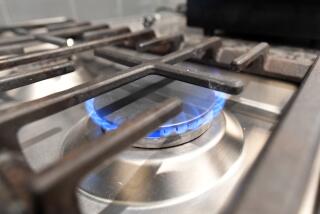Fan or Filter Could Be the Culprit Behind Stove Grease Found on Wall
- Share via
Q: Our 40-year-old house has a stove with a built-in range hood and blower that has never been adequate although it’s been cleaned and replaced several times. The current unit pushes the grease fumes so far that they accumulate and drip down the wall. Would replacing the entire vent pipe solve this?
D.G.L., Buena Park
*
A: The pipe is generally not the problem, says appliance repairman Dave Crisman of Huntington Beach.
Check the fan and filter again. Often, grease on the blades slows them. Make sure that they’re clean and that they turn freely.
Also, clean the filter at least three or four times a year if you use the stove often. Clean it with soap and water and run it through the dishwasher to give it a good scrubbing.
If neither of these work, check with a kitchen-bath shop to see if you need a more powerful fan.
*
Q: I want to install a new front door. The door jamb is in decent shape, but the threshold is not. There’s a gap between the door and threshold that is as large as a quarter of an inch in some places. Can I replace the existing threshold and keep the same jamb?
P.E., Fountain Valley
*
A: You should be able to remove the old threshold without damaging the door jamb, says Jim Gorman of Rancho Lumber in Westminster.
Check if there’s a sill or a strip of oak on top of the threshold that’s used to prevent excess wear to the threshold. If so, replacing the sill pretty much involves just pulling it up and nailing in a new one.
The threshold can take a beating, and it gets worn over time. On the new door, you may want to install a door sweep, a strip of rubber that goes on the bottom. It seals the door to the threshold when it closes. This will help prevent gaps.
*
Q: We recently purchased a home that has a considerable amount of red brick in the front entrance and patio area. A majority of them have developed a chalky white color. Is there a way to remove this oxidation? Also, what will remove oil and grease stains from brick?
A.J.S., Orange
*
A: What you’re probably seeing isn’t oxidation but lime coming out of the cement, says Bill Sink of Angelus Quarries in Santa Ana.
There are brick cleaners available at most masonry supply stores that will work, but it’s likely to come back. The culprit is water, which draws the lime out. You may be able to have more success keeping it away by cleaning it, letting the brick dry, then coating it with a good-quality outdoor sealer.
As for the grease stains, about the only thing that works well is water blasting with a high-pressure steam unit. You might be able to find at a rental yard, or you can have a pressure cleaning service come out and do the job.
*
Q: I have two sets of stainless-steel cooking pots purchased at least 30 years ago. The pots are in good condition, but the handles have broken off. The manufacturers are no longer in business. Is there any chance of getting replacement handles somewhere?
D.M.
Buena Park
*
A: Contact the manufacturers of modern cookware to see if their replacements fit your pots, suggests woodworker Dale Gentry of Anaheim Hills.
If that doesn’t work, see if some wood extensions can be used. Generally, the handle is made of plastic or wood, and it fits onto the metal portion that extends from the pot. You may want to contact a hobby shop that specializes in woodworking to see if they can help you find or make a replacement to fit.
If you have a question about your home or garden, A Helping Hand will help you find the answer. Send questions to John Morell, Home Design, The Times Orange County, 1375 Sunflower Ave., Costa Mesa, CA 92626.
More to Read
Inside the business of entertainment
The Wide Shot brings you news, analysis and insights on everything from streaming wars to production — and what it all means for the future.
You may occasionally receive promotional content from the Los Angeles Times.










